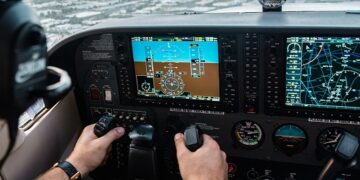GPS and INS are essential to global navigation systems, but both have their drawbacks. GPS signals can be blocked, jammed, or reflected by buildings and terrains, leading to signal distortion and inaccurate positioning. Additionally, signal accuracy decreases at high speeds and with rapid directional changes, making it less reliable for ultra-fast UAVs.
INS sensors suffer from drift due to poor initial calibration or sensor noise caused by mechanical vibrations, temperature fluctuations, cross-axis sensitivity, and wear. These sensors also require regular recalibration, particularly for high-precision applications.
Machine learning and deep learning methods offer solutions to enhance GPS/INS signal reliability and quality, and in some cases, can even replace them entirely.
The Future of Inertial Navigation and AI GPS Systems
Artificial neural networks have shown great promise in real-time object recognition and signal processing in automotive and manufacturing sectors. AI GPS is emerging as the next breakthrough in navigation systems.
Researchers have experimented with various deep learning algorithms to optimize inertial sensing and sensor fusion tasks for land, aerial, and maritime vehicles. One team developed visual-inertial odometry (VIO), integrating inertial and image sensors with deep learning to predict UAV positions with a 0.167 RMSE.
Another team used a convolutional neural network (CNN) to analyze noise information from inertial measurement units via the Kalman filter, enhancing position and orientation estimation. Tests with autonomous underwater vehicles demonstrated a 35.4% increase in positional accuracy over conventional methods.
AI GPS compensates for individual sensor limitations by enabling rapid data processing from auxiliary sources. By integrating multiple sensors and AI algorithms, vehicles can autonomously recalibrate, correct positional data, and operate efficiently in signal-compromised environments.
Benefits of AI-Assisted Navigation
- Enhanced situational awareness and adaptability
- Reduced reliance on satellite infrastructure
- Lower susceptibility to signal jamming
- Improved performance in complex terrains
- Advanced collision detection and prevention
- Better coordination for drone swarms
Real-World Applications of AI Sensor Fusion for Navigation
At Bavovna, we are developing an AI-powered PNT navigation system to enhance UAV inertial navigation. By using AI for sensor fusion, Bavovna’s algorithms enable safe high-speed operations and complex trajectories, even in GPS-compromised environments.
In a recent test, we piloted the Radiobird Defender 001, a multi-weather VTOL, on a 30-km mission, achieving an average end-point positioning error of 0.42-0.63%.
Navigation was achieved through sensor fusion from the onboard IMU array and airspeed sensors. We used a compass and barometer, with analysis performed on the edge using the Bavovna AI Navigation Kit. This kit employs a proprietary Kalman filtration algorithm and a fine-tuned sensor fusion neural network trained on over 100 hours of flight logs.
The SWaP-efficient hardware kit is enclosed in a protective casing to minimize environmental and electromagnetic warfare impacts. Core electronics are shielded with an EMI composite shield (-92 dBA/mm).
AI algorithms and sensor fusion offer precision comparable to GPS and GNSS but with greater reliability and resilience. This results in more efficient drone operations through enhanced autonomy, obstacle avoidance, and route optimization, even in GPS-denied environments.

























